Joining in with the rest of Gleeson in celebrating Women’s History Month the Electronic Resources & Systems (ERS) department would like to draw attention to two databases. We hope the USF community will make use of them this month!
North American Women’s Letters and Diaries
This indispensable resource represents the largest collection of women’s diaries and correspondence ever assembled. First hand personal observations of some 1,325 women are represented from across more than 300 years.

Reading diaries and letters may feel intrusive, like eavesdropping on intimate affairs of others, yet such material provides absorbingly rich details of the actual situations these women lived and thrived in. Making this such a valuable addition to Gleeson’s resources.
There are 150,000 pages of diaries and letters. This includes 7,000 previously unpublished pages of material. All indexed with biographies and bibliographies included to enhance the learning experience. Easily browsable, you are able to look up individuals by name, as well as places discussed and/or historical events, and there are over 2,000 Subject headings that may be skimmed through.
Women’s Magazine Archive
With full text of popular magazines ranging from the late-19th century up through 2005, this archival collection provides a broad view into the cultural norms confronting women in North America throughout the period; highlighting events, trends, and attitudes impacting women across a 100+ years.

Here’s Dorothy Sangster writing about Women’s College Hospital up in Toronto for the magazine Chatelaine in May 1961:
“Fifty years ago, in a rickety old house in a Toronto slum, pioneering women launched Canada’s first, and still only, hospital staffed by women.”
Sangster’s article takes readers through an engaging 24 hours of work performed by the all women staff. The Women’s College Hospital is still thriving today. Although some men are now employed there. Their website notes that in the same year this article appeared, “it became a teaching hospital affiliated with the University of Toronto, and the board amended the hospital’s bylaws to allow men to be appointed to medical staff,” …but only… “in the absence of a qualified woman.” [emphasis added]
The Women’s Magazine Archive does have plenty of room to grow. All publications in the archive may be viewed using the “Look up Publications” link, seen below:

An immediate observation might be made that the included magazine titles are predominately oriented solely to white women. Essence being the only included title marketed directly towards Black women or any women of color. With time it is to be hoped that the collection will be diversified and the much needed further non-white representation will be achieved.
On the lighter side, from out the earliest years in the archive, are several appearances of “Art Helps For Art Workers” an advice column in Ladies Home Journal from the 1890s written by Emma Haywood. “Every month” she responded to “questions relating to Art and Art work” sent in by readers.
Unlike the familiar “Dear Abby” columns of today, text of the letters presenting the questions asked were not included. Rather, after the initials or anonymous sign-off the reader used, only Haywood’s response is provided.
Her answers are direct and to the point. Sometimes abruptly so:
“E.S.—Proper gold burnishers are sold for the purpose.”
(Leaving perhaps all readers but E.S. to wonder just what “purpose” that might be?)
As well as offering practical information in regard to aspects of entering into freelance work with one’s art:
“SUBSCRIBER—Designs for book covers are usually prepared on paper in water-colors. I hardly think you will find your ideas salable unless you can yourself materialize them. There is no fixed rate of payment for such work.”
And she doesn’t back away from being critical:
“SUBSCRIBER—It is impossible to judge of your artistic ability by the sketch you send; it might have been scribbled by a young child. If you have a leaning toward art take some practical lessons; this course will develop any latent talent that you may have.”
While elsewhere giving practical, detailed advice on mixing colored oil paints:
“A.W.S.—For peaches in oils set your palette with raw umber, crimson lake, rose madder, ivory black, cobalt blue, raw sienna, light cadmium, ivory black, yellow and white.”
This may seem like a tremendous number of colors, yet it should be understood that:
“The coloring of peaches varies considerably”.

Featured image: Women Lawyers to Aid Mississippi Freedom Corps – Jet Magazine, July 9, 1964 [image cropped] by vieilles_annonces
